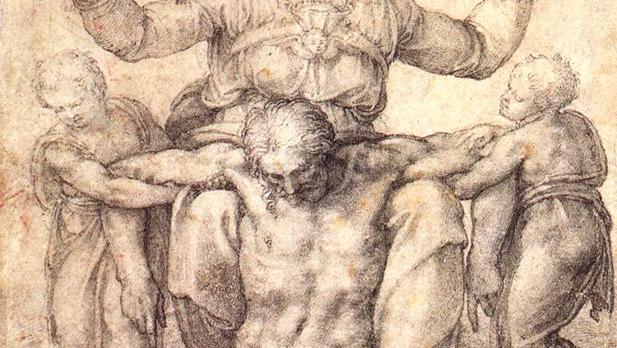You’ve heard of it, maybe: higher critical method, also called historical-critical method? It is the “tool” used in what is called the Quest for the Historical Jesus. As a method, it is a process of “deconstructing” the New Testament to get at the “real” Jesus of history, an attempt to reconstruct his earthly life to see if it matches up with what the Church says about him.
The essential question it asks is: Has the Church remembered Jesus accurately? Is there an actual continuity between a real Jesus, alive, teaching, and gathering followers, and a Jesus resurrected and exalted to God? Are both the same Jesus? It’s a way of asking “how did a nice Jewish boy like you end up savior of the world?”
This is not an unreasonable question. It was Thomas’ question in the Gospel of John. Thomas asking to touch the wounds of Christ was a demand to establish continuity between the crucified teacher he loved, and the one now standing before him. Was this the same Jesus?
We are now in the Third Quest of the Historical Jesus (“third quest” being a term coined by N.T. Wright) that began roughly in the 1970s and clacks along to this day. To say it is the third is to say there were a first and a second.
The first and second were both marked by deep skepticism that the Jesus in history matched up with the Jesus praised and worshipped in the Church. Liberal scholars, almost all European Protestants, stripped away all the accumulated layers of things they labeled myth. They offered correction to the misapprehending disciples (what was recorded was not what they think they saw), “naturalizied” miracle stories (Jesus did not feed the five thousand, he inspired them to share the food they were hoarding), and explained Jesus’ many healings as release from psychosomatic symptoms. They tried a scriptural reboot, correcting earlier “corruptions” or exposing outright “deceptions” found in scripture.
In the hands of scholarly skeptics, Jesus became a messianic revolutionary failure, or an inspirational sage who aroused legend and myth from overly enthused devotees. Or he was the invention of a cadre of people longingly desperate for someone to liberate them, a Jewish Zoro who fell down on the job. He was an unobservant Jew out to reform the Temple by organizing an agrarian revolt, a rural peasant who knew some magic tricks. Jesus was a wild-eyed apocalyptic delusionary who got himself crucified. As for being resurrected, that is the mythological consequence of disciples having a really bad grief reaction.
The gap between the “Jesus of history” (the one who wasn’t resurrected) and the “Christ of faith” (who was) got so wide and so wild many declared that knowing the Jesus of history was impossible. What mattered only was that Jesus lived, was crucified, and little else in between made any difference. Among those scholars, the life of Jesus cannot be argued historically, or reconstructed. But the “idea” of Jesus serves as an existential encouragement to humans, one that reaches beyond history to grasp whatever it was Jesus hoped to grasp. It’s just rather too bad it all got churchified. The history of higher critical method isn’t pretty.
But it has some bright spots. I do like higher critical method. Used properly (a key caveat) it will deepen Christian appreciation of scripture in a way that mere literalism cannot. Of all the major religions only Christians have deliberately undertaken such a thorough and sometimes disturbing examination of their own books, and in a way that, say, Islam cannot.
A recent release―a third quest example―by a German Protestant New Testament scholar, Jens Schröter, is a case in point. His Jesus of Nazareth: Jew from Galilee, Savior of the World concentrates on the two key issues in the Third Quest: how is the Jesus of faith also the Jesus of history? It is a question in distinction from the first and second quests, though it might seem a small one. If one sets out to prove the Jesus of the Church is not the Jesus of history, that’s pretty easy. Critics since Christian beginnings have been whacking at it. But asking instead how the Jesus of faith was the Jesus of history is something very different, and I think more challenging.
As Schröter explains it, the earliest followers of Jesus, after his crucifixion, declared him exalted Lord and resurrected Christ. This was their interpretation of Jesus in history. Why did they say that, unless that interpretation was based off the life of Jesus as they encountered him? Encountering Jesus, that’s still the evangelistic test for the Church.
In examining Jesus we discover time and again, Schröter puts it, “a story that has answers ready for the pressing questions that move human beings at different times. Therefore, the question of who Jesus was cannot be separated from the question of who he is today.”
Other good third quest New Testament examinations are N.T. Wright’s The Resurrection of the Son of God, and A Marginal Jew (don’t let the title mislead you) by Catholic scholar John Paul Meier. The effort is directed toward showing how Jesus of Nazareth is the resurrected Lord of faith. Such study inevitably sharpens Christian faith.
Russell E. Saltzman is a web columnist at First Things magazine and lives in Kansas City, Missouri. He can be reached at russell.e.saltzman@gmail.com.

